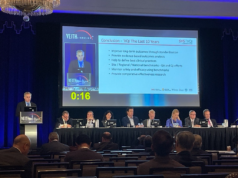 The quest for more data—specifically multicenter, independently adjudicated and, where possible, randomized—in the field of venous disease continues, with various trials currently underway set to provide some eagerly anticipated evidence. The path to best practice is long and winding, however. Many obstacles, among them variations in treatment approach, the difficulties of randomizing patients, and the lasting effects of a global pandemic, must all be overcome.
The quest for more data—specifically multicenter, independently adjudicated and, where possible, randomized—in the field of venous disease continues, with various trials currently underway set to provide some eagerly anticipated evidence. The path to best practice is long and winding, however. Many obstacles, among them variations in treatment approach, the difficulties of randomizing patients, and the lasting effects of a global pandemic, must all be overcome.
First dedicated IVC stent assessed in multicenter study
The Gore VIAFORT vascular stent inferior vena cava (IVC) study, which is being led by co-principal investigators Stephen Black (London, UK) and Kush Desai (Chicago, USA), is set to provide some much-needed data on the treatment for iliocaval obstruction.
Black, consultant vascular surgeon at Guy’s and St Thomas’ Hospital and professor of venous surgery at King’s College London, notes that the study is introducing the first dedicated IVC stent, which, he comments, “will give us something different for these patients and hopefully improve the outcomes in this difficult group”.

Desai, associate professor of radiology, surgery and medicine and director of deep venous interventions in the Division of Interventional Radiology at Northwestern University Feinberg School of Medicine, goes into detail about the rationale for conducting the study. “There are now several investigational device exemption [IDE] trials for iliofemoral disease, where we have devices provided by numerous companies that have been investigated in similar—but not identical—fashions for iliofemoral venous obstruction,” he says. There is a “gaping hole” in the evidence base when it comes to iliocaval disease, however, which, Desai notes, is particularly noticeable in relation to on-label and purpose-built treatments for IVC obstruction.
This gap in the literature is made starker by the fact that management of IVC obstruction is typically more complex than that of iliofemoral obstruction. Desai notes that a large part of his and his colleagues’ practice is the treatment of IVC obstruction, and that these patients are “significantly more challenging from multiple perspectives, not only technically, but with regard to long-term management and ensuring the best options for patency”.
“There really was a compelling need for an iliocaval obstruction device,” he tells Venous News. This need, he notes, was recognised by Gore, which proceeded to build a device designed specifically for this anatomy.
The current landscape of care for iliocaval obstruction is, according to Desai, “a bit all over the place”. He explains that treatment is currently all off-label in this space. Some physicians use legacy stents like the Wallstent (Boston Scientific), he explains, while others—including Desai and Black—perform double-barrelled reconstructions with off-label iliofemoral stent designs. “In addition to the lack of multicenter data for the treatment of iliocaval obstruction, you have such a variety of approaches, which hinders progress,” Desai summarizes.
Desai reports that the VIAFORT study is now “well under way,” with the hope being that the trial will be fully enrolled by the end of the year.
Despite the good progress being made, Desai shares that the investigators continue to face a series of challenges. One of these relates back to Desai’s point about there being such a variety of approaches to treating IVC disease. “We’re finding that people have just so many different ways of doing it and, in order to have a trial that is scientifically rigorous and also, frankly, useful in terms of what it tells us about the disease state and how to move forward, you have to have some sort of coherence in approach, and that’s probably one of the bigger challenges from this trial,” he says.
Looking ahead, Desai underscores two main hopes for the VIAFORT study. One is that venous practitioners will have a proven, purpose-built system for iliocaval obstruction management. The second and “probably one of the more exciting things about this trial” is that it will be the first multicenter, independently adjudicated trial to look at iliocaval obstruction management in a space where the literature includes mainly single-center, retrospective studies.
Desai is keen to see more multicenter efforts with independent adjudication going forward. “The reported literature for outcomes in venous disease mainly come from single-center attempts, and once you subject a therapy to scrutiny—through not only a multicenter approach but independent adjudication of data—the truth can be quite different,” he says.
PTS patients soon to have randomized data backing care
Another dataset in the making is due to provide randomized evidence for patients suffering from post-thrombotic syndrome (PTS). Suresh Vedantham (St Louis, USA) is principal investigator of the C-TRACT trial—a multicenter RCT evaluating if the use of iliac vein stent placement along with standard PTS care is superior to standard PTS care alone in improving PTS severity and quality of life. The study is sponsored by the National Heart Lung and Blood Institute (NHLBI) of the National Institutes of Health (NIH).
Vedantham, professor of radiology and surgery at Washington University School of Medicine, states that it is not currently known if the clinical change observed in single-arm venous stent studies of patients with PTS is due to stent placement, or other factors.

Remarking more broadly on the landscape of care for the group of patients this trial aims to help, Vedantham shares that, “sadly, most patients with PTS suffer without being diagnosed”. He continues that, for the minority of patients that are diagnosed, PTS care is heterogeneous—a reflection of the absence of evidence-based therapies that show a consistent ability to help patients. Beyond providing data on venous stent placement, Vedantham says, the ambition for C-TRACT is “to help raise awareness of PTS and increase the number of patients who receive dedicated attention to it”.
While enrollment in the trial is well underway, Vedantham points out that randomization has proved difficult. By way of context, he stresses that it is notoriously difficult to randomize patients into endovascular therapy trials across disease states, with C-TRACT being no exception.
“Medical and endovascular therapies are very different, so some patients have a strong preference towards one or the other, and are unwilling to be randomized,” he says. In addition, Vedantham notes that medical physicians are less knowledgeable about endovascular therapies, while proceduralists can be “exceedingly ‘pro-intervention’”.
Furthermore, he details that very few physicians receive dedicated training in recruitment science and best practices. As a result, Vedantham explains, “it takes a major study-specific effort to train investigators on properly communicating clinical equipoise to a potential participant”.
The wide availability of and reimbursement for some procedures compounds the aforementioned problems, Vedantham adds.
Finally, he points out that asking an endovascular provider to refer a patient to another endovascular provider who is located at a study site “flies against current culture”. Vedantham concludes on a positive note, however, opining that “there are many opportunities for collective improvement in terms of shifting the culture, incorporating technology, and prioritizing the most rigorous studies”.
Randomization has not been the only challenge. “[COVID-19’s] onset came right after a critical investigator meeting, when C-TRACT was about to take off,” Vedantham recalls. “Due mainly to coordinator turnover issues, C-TRACT closed more than a third of its study sites,” he details.
The investigators have had to make changes, with many follow-up visits now conducted remotely. There is an upside to this, however, which is that the adaptations “appear to have largely succeeded in enabling us to maintain data completeness”.
“Going forward, I hope it will be relatively smooth sailing.”









